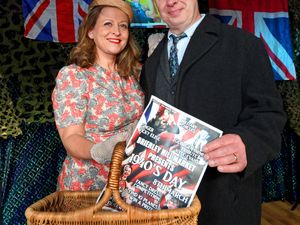Real life: Wolverhampton glassblower Hayley Gammon is a real glass act
Turning hot molten glass into something beautiful requires concentration and an ability to think on your feet.
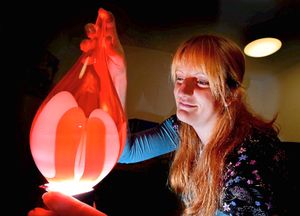
And for craftswoman Hayley Gammon, who has been blowing glass for more than a decade, that’s what makes this creative art form so appealing.
“It’s quite instant in nature. When you start a piece of glass, you have to finish it there and then.
“You can’t put it down, walk away from it and have a cup of tea, you have to complete it otherwise it will be ruined,” she tells Weekend.

Hayley has spent many years honing her skills and now has her own studio at the Makers Dozen workshop complex at Wolverhampton Art Gallery.
Her first experience with glass was while she was studying for a BA Honours degree in 3D design at Manchester Metropolitan University.
She enjoyed it so much that she went on to complete a BTEC course in glass techniques and technology at Dudley College’s International Glass Centre.
Since then she has worked with master craftsmen and women across the UK learning the art of handmade glass blowing, which is one of the oldest art forms in the world.
Glass blowing is the practice of shaping a mass of glass that has been softened by heat by blowing air into it through a tube or pipe.
Glass starts as sand and when it is heated to a high temperature it melts to form liquid glass. While it is hot it can be formed into different shapes then cooled to become solid again.
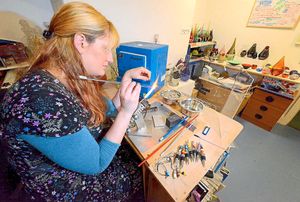
A glass blower will start the process by putting the tip of the pipe into the furnace to heat it. This is because it will allow the molten glass to go onto the pipe evenly and without any bubbles.
The pipe is put into the molten glass in the furnace and continually rotated to get an even gathering of glass – similar to gathering treacle onto a spoon.
It’s important to keep the pipe rotating at all times to make sure that the glass doesn’t sag downwards and lose it’s shape.
Using the mouth, they carefully begin to blow air through the cool end of the pipe until the glass is expanded to the size required.
It’s then shaped and new colours added as necessary according to the design. The glass needs to be kept between 1,500F to 1,800F throughout the whole process and it can be reheated inbetween steps as needed.
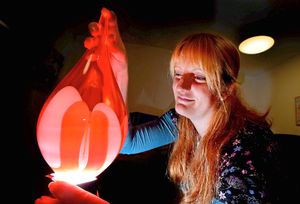
A lehr or annealer is used to cool the glass slowly to keep it from cracking or shattering due to thermal stress.
Afterwards the glass blower may use ‘cold working’ techniques such as sandblasting, cutting and polishing to finish the piece.
Hayley, who lives with her partner and fellow glass maker Darren Weed in Wolverhampton, says anyone working with glass is always kept on their toes.
“You only really get one chance with glass, it’s constantly evolving so you have to work quickly to manipulate it in the way that you want.
“Although you are using the same techniques, every piece can be different,” explains the 31-year-old, who was an artist in residence at the University of Wolverhampton in 2015.
Hayley, who does her glass blowing at two larger studios nearby, says she finds pleasure in every stage of the creative process.
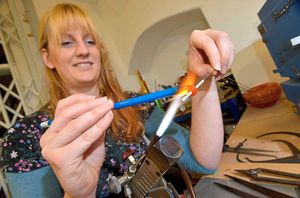
“I enjoy the high pressure of the hot shop where it either works or doesn’t work and you have to work very quickly to get the shape and forms that you want.
“But I also like the cold work where you cut, polish and finish the pieces off. It’s really nice and relaxing because it can be quite repetitive and rhythmic.
“Some glassmakers don’t enjoy this stage but I do. I like that you can take your time with it which you can’t do in the hot shop,” she says.
During her residency at the University of Wolverhampton she created a series of pieces called Trail which saw her experimenting with the use of intertwining bands of coloured and clear glass.
“I like the transparent look because it has more of a glassy look to it than a solid colour. I start with a transparent colour and then I put an opaque colour on top of that known as a half overlay.
“It’s actually an optical illusion that makes it look like it runs through the glass,” explains Hayley.
She says she tends to create non-functional items but is also pleased when customers have a use in mind for her pieces.
As well as glass blowing Hayley also practices and teaches lamp-working, which she does from her studio in Wolverhampton.
This is where a blow torch is primarily used to melt the glass and is a techniques used to create smaller pieces such as beads for jewellery and sculptures.
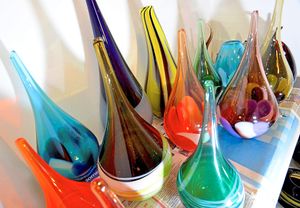
The glass is heated until molten, wound around a specially coated steel mandrel, forming the base bead.
Once in a molten state, the glass is formed by shaped with tools and hand movements.
Hayley, who lives in Wolverhampton, is part of a large community of glassmakers who are finding there is a great demand for their work.
“Five years ago people may not have spent their money on items like this because they were concentrating on larger expenses like buying a house.
“But now it’s harder for people to buy a house because many can’t afford it so they are instead thinking more about making the homes they have nice.
“I think more people appreciate how long it takes to make a piece and the skills involved in creating it,” she says.
“This area is a great area to be in for glass making, not just because of the history and heritage but also because people are always experimenting and trying new things. There is so much to learn.
“I love making glass and I’ve been lucky to have worked with some great people and had opportunities to learn and develop my skills.”
To see more of Hayley’s work and to find out about lamp-working lessons go online to www.hayleyglassdesigns.co.uk


